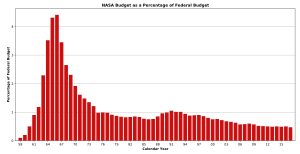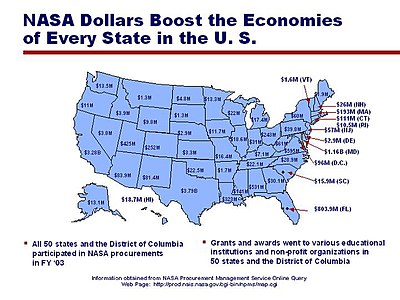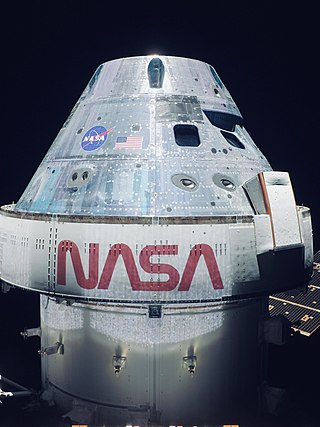| Calendar Year | NACA Budget [3] |
|---|
| Nominal Dollars (Millions) | %of Federal Budget [4] | 2022 Constant Dollars
(Millions) |
|---|
| 1915 | 0.005 | 0.00% | 0.128 | | 1916 | 0.005 | 0.00% | 0.119 | | 1917 | 0.088 | 0.00% | 1.770 | | 1918 | 0.112 | 0.00% | 1.920 | | 1919 | 0.205 | 0.00% | 3.067 | | 1920 | 0.175 | 0.00% | 2.265 | | 1921 | 0.200 | 0.00% | 2.892 | | 1922 | 0.200 | 0.01% | 3.081 | | 1923 | 0.226 | 0.01% | 3.414 | | 1924 | 0.307 | 0.01% | 4.646 | | 1925 | 0.470 | 0.02% | 6.951 | | 1926 | 0.534 | 0.02% | 7.808 | | 1927 | 0.513 | 0.02% | 7.630 | | 1928 | 0.550 | 0.02% | 8.324 | | 1929 | 0.837 | 0.03% | 12.665 | | 1930 | 1.300 | 0.04% | 20.147 | | 1931 | 1.321 | 0.04% | 22.493 | | 1932 | 1.051 | 0.02% | 19.856 | | 1933 | 0.920 | 0.02% | 18.316 | | 1934 | 0.954 | 0.01% | 18.419 | | 1935 | 1.256 | 0.02% | 23.723 | | 1936 | 2.544 | 0.03% | 47.366 | | 1937 | 1.631 | 0.02% | 29.306 | | 1938 | 1.281 | 0.02% | 23.510 | | 1939 | 4.064 | 0.04% | 75.669 | | 1940 | 4.180 | 0.04% | 77.274 | | 1941 | 11.200 | 0.08% | 197.2 | | 1942 | 19.866 | 0.06% | 315.4 | | 1943 | 25.429 | 0.03% | 380.4 | | 1944 | 38.392 | 0.04% | 564.6 | | 1945 | 40.942 | 0.04% | 588.7 | | 1946 | 24.052 | 0.04% | 319.2 | | 1947 | 30.713 | 0.09% | 356.4 | | 1948 | 43.449 | 0.15% | 466.6 | | 1949 | 48.652 | 0.13% | 529.1 | | 1950 | 128 | 0.30% | 1,374.6 | | 1951 | 63.068 | 0.14% | 627.8 | | 1952 | 69.000 | 0.10% | 673.9 | | 1953 | 66.286 | 0.09% | 642.5 | | 1954 | 62.439 | 0.09% | 600.7 | | 1955 | 55.860 | 0.08% | 539.4 | | 1956 | 72.700 | 0.10% | 691.7 | | 1957 | 76.677 | 0.10% | 706.2 | | 1958 | 117 | 0.14% | 1,847.3 | | 1959 | 101 | 0.11% | 2,188.8 |
| Calendar
Year | NASA budget |
|---|
Nominal Dollars
(Millions) | % of Fed Budget [5] [6] | 2022 Constant Dollars
(Millions) |
|---|
| 1958 | 89 | 0.1% | 903 | | 1959 | 145 | 0.2% | 1,456 | | 1960 | 401 | 0.5% | 3,967 | | 1961 | 744 | 0.9% | 7,286 | | 1962 | 1,257 | 1.18% | 12,161 | | 1963 | 2,552 | 2.29% | 24,394 | | 1964 | 4,171 | 3.52% | 39,356 | | 1965 | 5,092 | 4.31% | 47,285 | | 1966 | 5,933 | 4.41% | 53,513 | | 1967 | 5,425 | 3.45% | 47,612 | | 1968 | 4,722 | 2.65% | 39,737 | | 1969 | 4,251 | 2.31% | 33,923 | | 1970 | 3,752 | 1.92% | 28,273 | | 1971 | 3,382 | 1.61% | 24,438 | | 1972 | 3,423 | 1.48% | 23,947 | | 1973 | 3,312 | 1.35% | 21,833 | | 1974 | 3,255 | 1.21% | 19,315 | | 1975 | 3,269 | 0.98% | 17,778 | | 1976 | 3,671 | 0.99% | 18,879 | | 1977 | 4,002 | 0.98% | 19,327 | | 1978 | 4,164 | 0.91% | 18,683 | | 1979 | 4,380 | 0.87% | 17,661 | | 1980 | 4,959 | 0.84% | 17,613 | | 1981 | 5,537 | 0.82% | 17,823 | | 1982 | 6,155 | 0.83% | 18,665 | | 1983 | 6,853 | 0.85% | 20,135 | | 1984 | 7,055 | 0.83% | 19,872 | | 1985 | 7,251 | 0.77% | 19,729 | | 1986 | 7,403 | 0.75% | 19,764 | | 1987 | 7,591 | 0.76% | 19,553 | | 1988 | 9,092 | 0.85% | 22,497 |
| Calendar
Year | NASA budget |
|---|
Nominal Dollars
(Millions) | % of Fed Budget [5] [6] | 2022 Constant Dollars
(Millions) |
|---|
| 1989 | 11,036 | 0.96% | 26,054 | | 1990 | 12,429 | 0.99% | 27,840 | | 1991 | 13,878 | 1.05% | 29,818 | | 1992 | 13,961 | 1.01% | 29,114 | | 1993 | 14,305 | 1.01% | 28,979 | | 1994 | 13,695 | 0.94% | 27,039 | | 1995 | 13,378 | 0.88% | 25,693 | | 1996 | 13,881 | 0.89% | 25,901 | | 1997 | 14,360 | 0.90% | 26,178 | | 1998 | 14,194 | 0.86% | 25,484 | | 1999 | 13,636 | 0.80% | 23,954 | | 2000 | 13,428 | 0.75% | 22,819 | | 2001 | 14,095 | 0.76% | 23,295 | | 2002 | 14,405 | 0.72% | 23,437 | | 2003 | 14,610 | 0.68% | 23,242 | | 2004 | 15,152 | 0.66% | 23,475 | | 2005 | 15,602 | 0.63% | 23,378 | | 2006 | 15,125 | 0.57% | 21,956 | | 2007 | 15,861 | 0.58% | 22,385 | | 2008 | 17,833 | 0.60% | 24,239 | | 2009 | 17,782 [7] | 0.57% | 24,255 | | 2010 | 18,724 [8] | 0.52% | 25,127 | | 2011 | 18,448 [9] | 0.51% | 23,999 | | 2012 | 17,770 [10] | 0.50% | 22,651 | | 2013 | 16,865 [11] | 0.49% | 21,187 | | 2014 | 17,647 [12] | 0.50% | 21,814 | | 2015 | 18,010 [13] | 0.49% | 22,235 | | 2016 | 19,300 [14] | 0.50% | 23,534 | | 2017 | 19,508 [15] | 0.47% | 23,290 | | 2018 | 20,736 [16] | 0.50% | 24,165 | | 2019 | 21,500 [17] | 0.47% | 24,609 | | 2020 | 22,629 [18] | 0.48% | 25,509 | | 2021 | 23,271 [19] | | |
|















